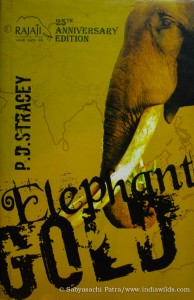Elephant Gold – by P. D. Stracey
As the name suggests, Elephant Gold by P.D. Stracey is a gem of a book giving us an unique insight into elephant behaviour from an Anglo-Indian man who started his career as a Khedda Officer in the Assam Forest Department in the pre-independence India.

Elephant Gold
In those days when the human population was low and large swathes of India was blessed with pristine wilderness, some wildlife like tiger, large deer stags and gaurs were seen as trophies to own and others like elephants were captured for their help in logging, engaging in difficult tasks as well as for religious and prestigious possessions by the wealthy. In such times, he was among the initial ones and his efforts have been detailed in the chapter Pioneer Elephant Catchers. He has given very detailed accounts of all aspects related to elephant catching and those are found in the chapters Theories and Facts, Capturing Elephants, Noosing Elephants, Elephant Drives, Handling and Training, Doctoring elephants etc.
However, his book is not just a monotonous description of the process to be called a manual. This book shows his keen sense of observation while he was learning the craft from the local elephant catchers known as phandis.
He describes in detail the behaviour of the elephants while noosing, in the stockade, their spirit as well as some quirks.
He delves into various methods of elephant capturing used in different places from India as well as in other Asian countries and it is an interesting read.
In the chapter titled Theories and Facts, he looks into the myth of a secret common natural burial place of elephants in the wild as well as whether elephants choosing a river to die etc. He examines the topic of maximum age of elephants, height of elephants as well as the musth phase. His observations regarding musth are interesting.
He says the Indian term for any unexplainable behaviour on the part of a man or animal is pagla, meaning mad and I do not think the term should be applied to animals, even in the case of a musth elephant, as the various forms of true insanity are confined to Homo sapiens. I believe, however, that all cases of assaults and sudden killings by domesticated elephants are either associated with the condition of musth or must be attributed to some provocation. (page 58)
The persistence of a large male elephant in musth is beyond belief.on one occasion we met a very large makhna or tuskless elephant, his cheeks pouring with musth fluid. He had in tow a small cow elephant which he had abducted from a neighbouring garden; her leg chains were still on and could be heard distinctly as she walked. As I was on a male elephant, we gave the wild makhna a wide berth; but he persisted on following us, with his little companion trailing behind, and in spite of our shouting he got closer and closer. I did not know exactly what his intentions were, but it was obvious that he resented the presence of our male elephant which he took to be a rival. Eventually the mahout got so nervous that I had to fire my gun. (page 60)
The author believes except in a fight, an elephant is definitely handicapped by really long, heavy tusks, particularly when negotiating thick forest. This is one reason why tuskers are not used in the noosing of wild elephants in mela shikar, nor are they popular on shooting excursions, where a staunch female is hard to beat. (Page 61)
Regarding sexual acts of elephants he says It is wrong to belief that only an elephant in musth demands or is capable of sexual congress. Musth is a sign of sexual maturity, but it is the female which comes into season and decides the matter. There are no obvious signs, except that the males will start paying attention to a particular cow, who makes little twittering noises and behaves in a peculiar manner which is revealing only to those who have experience of elephants
P.D. Stracey recounts an interesting incident where his male elephants tried to mount on a cow elephant without any fight among themselves.
One by one the big koonkis attempted to mount the cow and without any show of haste, violence or anger. It was surprising to see that some of the males in apparently good condition were unable to complete the act, whereas one of the Miri-owned koonkis, Kansira Goonda, who at all times was an animal of comparatively poor condition and looks, proved the most effective. He further says that while this incident was being played out in the middle of the depot, with all the men silent spectators but standing back in the shadow of the huts. This was surprising to me the dignity with which the men witnessed the act, matching that of the animals which participated in it. The mating of dogs or horses or cattle invariably excites ribaldry and laughter among the spectators, but not this.
He also gives an account of the cruelty involved in the training methods as well as the prevailing practice of killing adult males who get into the stockade as they cant be tamed. It also gives a peek into the psychological stress brought on elephants during the capturing and taming process.
Large male elephants are by no means welcomed by elephant catches because of the impossibility of handling them with the available koonkis and because of the damage they inflict on the smaller elephants in the stockade. A group of captured elephants is a group of frightened wild creatures; huddled together head to tail, the picture is a pathetic one. In the pushing, seething mass the adolescents bear in towards the centre, trying to hide their heads like ostriches under the adults. The larger elephants are more dignified, but the strain and tension tells on them too and occasionally they burst into furious assault on each other. Tusks are used freely to push aside those elephants which get in the way, while tails are bitten and maknas and females open their mouths wide and use their tushes to bear downwards on head and shoulder. (Page 113)
The author recounts an astonishing incident of a female elephant captured after 14 years of it escaping from the camp.
A party of mela shikar koonkis were hunting when they came on a cow elephant with two calves at heel, one of them a suckling calf. When she displayed no fear but stood looking at the tame elephants, one of the mahouts instinctively felt that she was an escapee. Taking a chance, he shouted loud and commandingly to her, Baito! Baito! (Sit down! Sit down!) And to the astonishment of everyone the elephant sat down! The phandi immediately jumped from his kookin and running up to the elephant, caught her by the ear and scambled up on to her neck. The bigger of the two calves ran away, but the little one followed at her heels as she was ridden back to the depot in triumph, the centre of admiration and the butt of jokes of the elated men, who jeered at her stupidity in being recaptured so easily.
This incident shows that an elephant once subjugated and trained by its trainers is so broken psychologically that it can never overcome the training and truly escape.
This book “Elephant Gold” is packed with many such interesting incidents that are not only thought provoking but also serve as great learnings for a student of natural history.
This hardbound book with 227 pages was first published in 1963. Its first Indian edition was in 1991 by Natraj Publishers. It is priced at 495 rupees but is available much cheaper online. In Amazon you can find it at only Rs. 306/- where as in flipkart it was available for Rs. 470/-.
Highly Recommended.
- GoPro Hero 12 Black - 6 September,2023
- Leopards: The Last Stand - 2 July,2023
- Drifting in the Waters of Sundarbans - 26 March,2023











My father started his career as a tea planter – he met Mr Stracey (the author) a number of times in Dehradun- he remembers him as an incredibly jolly person
Hi Saurabh,
Great to know that your father had met Mr P D Stracey. Thanks to you, we now know a little bit more about Mr Stracey’s personality.
Cheers,
Sabyasachi
I live in kaziranga, when I read anything on elephant, I remember the P.D Straceiys great book elephant gold which is not available. I think we were not lover of elephant till date. Thank you sir, atleast today I have been known fews to elephant gold.
P.D. Stracey’s wife was my father’s cousin. However, by the time I came of age and became interested in getting to know my relatives better, the couple had passed away. I’d be grateful to anybody who can provide details of the couple’s lives.